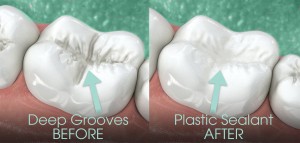What Are Dental Sealants?

Dental Sealant Before and After
A dental sealant is a thin plastic coating (usually clear or white in color) that is applied to the chewing surface of your tooth, which shields the enamel from further decay by “sealing out” food, plaque and bacteria. Dental sealants are meant to prevent the need for dental fillings, and require no drilling to the enamel or dentin in order to be applied. The great thing about dental sealants is that they are invisible — no one will even notice they are there. However, they can make a big difference in whether or not your tooth gets a cavity or not.
What Are the Benefits of Dental Sealants?
Dental sealants act as a barrier to prevent cavities. According to the American Academy of Pediatric Dentistry (AAPD), “sealant placement in children and adolescents has shown a reduction of cavities’ incidence [by] 86 percent after one year and 58 percent after four years.” Thorough brushing and flossing help remove food particles and plaque from smooth surfaces of teeth. Unfortunately, there are areas that, despite your good efforts, the toothbrush bristles just cannot reach. Deep depressions and grooves in teeth trap food particles and allow plaque to collect. When you eat, the bacteria in plaque use the sugars in your food to produce acids that eat away at the tooth enamel. Repeated attacks cause the enamel to break down, eventually resulting in a cavity (or hole) in the tooth surface.
Who Benefits from Dental Sealants?
Children are prone to cavities because of the natural shape of their growing teeth. When first molars come in around age 6, deep crevices called “pits” and “fissures” form on the chewing surfaces of these back teeth. Dental sealants are recognized as an effective approach to preventing pit and fissure cavities in children. Although sealants are commonly recommended for children and teenagers, they are also a good preventative treatment for adult patients with no tooth decay or fillings in their back teeth. Prevention is the best approach to keeping your oral health in optimum shape.